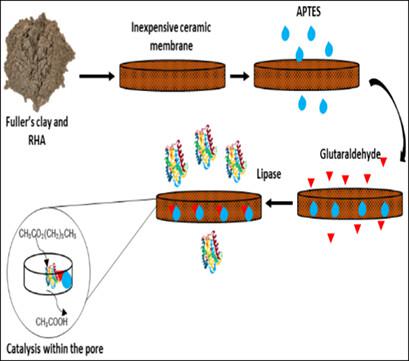当前位置:
X-MOL 学术
›
Chem. Eng. Technol.
›
论文详情
Our official English website, www.x-mol.net, welcomes your feedback! (Note: you will need to create a separate account there.)
Maximizing Efficiency and Affordability with Ceramic Membranes for Enzyme Immobilization
Chemical Engineering & Technology ( IF 2.1 ) Pub Date : 2023-12-05 , DOI: 10.1002/ceat.202300383 Padmashree Ranganathan 1 , Vinoth Kumar Raja 1
Chemical Engineering & Technology ( IF 2.1 ) Pub Date : 2023-12-05 , DOI: 10.1002/ceat.202300383 Padmashree Ranganathan 1 , Vinoth Kumar Raja 1
Affiliation

|
Low-cost ceramic microfiltration membranes were explored for immobilizing lipases. Expensive commercial ceramics (e.g., alumina, zirconia) have advantages like chemical robustness, but high sintering temperatures limit their usability. To overcome this, researchers used Fuller's earth clay with rice husk ash to create cost-effective membranes. However, fewer reactive sites on ceramic surfaces hinder enzyme immobilization. To address this, 3-aminopropyltriethoxysilane and glutaraldehyde activated the membrane for covalent lipase binding. The immobilized membrane retained activity for over five 1-h reaction cycles with a minimal performance decline of around 60 %. After five cycles, it retained over 40 % of the initial activity. These results show promise for using low-cost ceramic membranes in various industries, such as in food, beverages, pharmaceuticals, and chemical production.
中文翻译:

利用陶瓷膜固定酶,最大限度地提高效率和经济性
人们探索了低成本陶瓷微滤膜来固定脂肪酶。昂贵的商用陶瓷(例如氧化铝、氧化锆)具有化学稳定性等优点,但高烧结温度限制了它们的可用性。为了克服这个问题,研究人员使用富勒粘土和稻壳灰来制造具有成本效益的膜。然而,陶瓷表面上较少的反应位点阻碍了酶的固定。为了解决这个问题,3-氨基丙基三乙氧基硅烷和戊二醛激活了膜以进行共价脂肪酶结合。固定膜在超过 5 个 1 小时的反应周期内保持活性,性能下降最小,约为 60%。五个周期后,它保留了超过 40% 的初始活性。这些结果显示了在食品、饮料、药品和化学品生产等各个行业中使用低成本陶瓷膜的前景。
更新日期:2023-12-05
中文翻译:

利用陶瓷膜固定酶,最大限度地提高效率和经济性
人们探索了低成本陶瓷微滤膜来固定脂肪酶。昂贵的商用陶瓷(例如氧化铝、氧化锆)具有化学稳定性等优点,但高烧结温度限制了它们的可用性。为了克服这个问题,研究人员使用富勒粘土和稻壳灰来制造具有成本效益的膜。然而,陶瓷表面上较少的反应位点阻碍了酶的固定。为了解决这个问题,3-氨基丙基三乙氧基硅烷和戊二醛激活了膜以进行共价脂肪酶结合。固定膜在超过 5 个 1 小时的反应周期内保持活性,性能下降最小,约为 60%。五个周期后,它保留了超过 40% 的初始活性。这些结果显示了在食品、饮料、药品和化学品生产等各个行业中使用低成本陶瓷膜的前景。



























 京公网安备 11010802027423号
京公网安备 11010802027423号